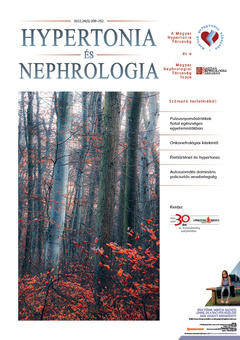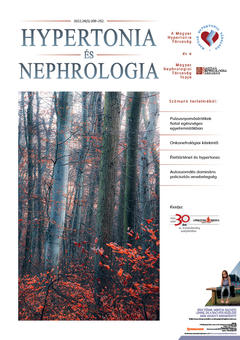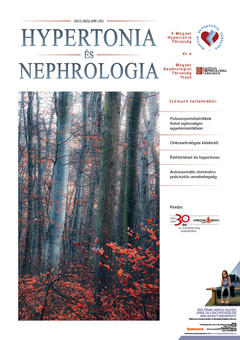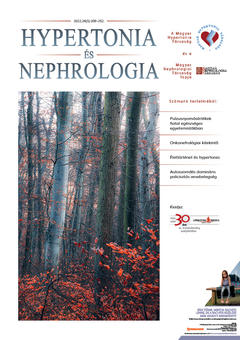The eLitMed.hu medical portal uses computer cookies for convenient operation. Detailed information can be found in the Cookie-policy.
Hypertension and nephrology - 2022;26(5)
Content
[Pulse pressure values of young healthy university students: gender specificity and deviations from the optimal]
[Although the interpretation of arterial pulse pressure (PP) is more difficult than other blood pressure values, it can provide information regarding the stiffness of the large arterial vessels and the level of peripheral resistance. Both can vary with age and physical activity. Despite the importance of PP, the most recent 2018 ESC/ESH Clinical Practice Guidelines for the Management of Arterial Hypertension does not address PP in detail or its significance, and it is not routinely evaluated. Indeed, there is limited data on PP in physically active young people and its possible gender differences. We hypothesised that PP may show extreme values and gender differences in physically active young people. Methods: University students were recruited in the present study (N=64; 51.6% male) with a mean age of 23.2±2.7 years, the youngest was 18 and the oldest 28 years old. An automatic sphygmomanometer (Omron MIT5) was used to measure blood pressure and heart rate (HR) by placing it on the top half of the arm. Measurements were taken in a relaxed, sitting position and repeated three times at one-minute intervals. Results: Body mass index (BMI, kg/m2): women 22.1±2.7; men 24.1±2.9. Blood pressure (mmHg): systolic 118.7±13.4; diastolic 73.7±9.3; resting heart rate (HR 1/min): 74.3±12,7 and PP was 44.9±12.6. Women had lower systolic pressures (110.6±10.9; min.-max.: 92–130 mmHg) than men (126.2±10.9; min.-max.: 97–146.5 Hgmm, p<0.001), no significant difference was in diastolic values between gender. Women had higher HR (78.2±13.4; min.-max.: 54–116.5 beats/min) than men (70.6±10.9; min.-max.: 46–90.5; 1/min, p=0.017). Women had lower PP (37.1±9.4) than men (52.3±10.6; p<0.001). The lowest PP was 20 mmHg in women and the highest was 62 mmHg. In men, the lowest PP was 24.5 mmHg and the highest was 74.5 mmHg. Conclusions: In this study, we characterized the arterial pulse pressure values specific to young adult age (~25 years) and gender, which is important because the ESC/ESH Guidelines for hypertension does not provide a range (‘normal’ range) to age or gender reference values. Furthermore, our data confirm the previous assumption that PP is lower in young women than in young men. Importantly there was considerable variability in PP and many young men had PP values above 40 mmHg, which may be associated with cardiovascular risk factors, thus measurement and monitoring of PP may be warranted even at a young age.]
[An onconephrology outlook]
[Due to the improved life expectancy and longer survival in patients with cancer caused by the breakthrough results achieved in the treatment of cancer, it is of increasing importance to know more precisely the short- and long-term complications and side effects that arise in connection with new types of oncotherapies. During the treatment of patients with cancer, the two most common life-threatening complications that could develop after chemotherapy are acute renal failure and tumor lysis syndrome, which requires nephrology consultation in all cases. Meanwhile the therapeutic palette in oncology is developing, we have to count with an increasingly diverse nephrotoxic side effect profile. Currently, conventional chemotherapy is still the most commonly used anti-tumor therapy, therefore it is extremely important to learn about the kidney complications associated with the use of these drugs and the potential prevention strategies, however, we also have to take into account the nephrotoxic effects of new types of immunotherapies and molecularly targeted therapies in everyday clinical practice. As a result of the multidisciplinary approach, nephrologists also play an increasingly important role in oncology care, and the appearance of a rapidly evolving new subspecialty, called clinical onconephrology, can be observed.]
[Life history and hypertension – or: where can cardiovascular prevention begin?]
[The relationship between psychosocial stress and hypertension has been the subject of research for decades. Stress and sympathicoadrenal activation play a central role in the pathogenesis of hypertension, yet we cannot state that there is a linear relationship between the amount of stress and blood pressure. The response of individuals to stressful situations can be extremely different, and the response to stressors is highly dependent on personality structure. But do hereditary or acquired traits determine the stress response? How do negative life events affect this? Do innate traits or learned patterns of behavior play a key role? Can it be influenced and, if so, how?]
[Autosomal dominant polycystic kidney disease and tolvaptan]
[Autosomal dominant polycystic kidney disease is the most prevalent monogenic, inherited kidney disease, responsible for 5-10% of end stage kidney disease cases. The pathogenic mutations of the polycystin coding-genes result in increased fluid transport, proliferation and eventually in cysts formation. Diagnosis rests on the ultrasound imaging and family history and genetic tests are not necessary except in atypical cases. The clinical symptoms include hypertension, hematuria, proteinuria and progressive GFR decline together with extrarenal manifestations. The differential diagnostic problem is the exclusion of other cystic kidney diseases. The therapeutic strategy needs a complex approach, in which establishing the rate of progression is fundamental. Two different classification systems, the Mayo-classification – based on total kidney volume – and PROPKD-score guide us to determine prognosis. Before 2016 the cornerstones of therapy were sodium- and calory restrictions as well as antihypertensive drugs. Since 2016 tolvaptan, a V2-receptor antagonist is available. Based on pivotal studies (TEMPO 3:3; TEMPO 34, REPRISE) tolvaptan reduced GFR decline and kidney volume progression. In this review we focus on pathophysiology, presentation and main messages of the updated recommendations on tolvaptan use. Novel research suggests, that modification of different signaling pathways – such as somatostatin analogues, EGFR- or mTOR-inhibitors could serve as therapeutic options in the future.]
[Rhabdomyolysis as the first clinical sign of biliary obstruction]
[The most common side effects of the widely prescibed statin therapy are muscle related symptoms. The most severe complication is rhabdomyolysis, which carries potencial life threatening consequences. After the initiation of treatment of the clinical situation we have to search for the etiology as well. Beside certain conditions predisposing to muscle injury, the key point may be the change in statin metabolism. Here we present the case of a statin induced rhabdomyolysis not caused by drug interaction, but due to the impared biliary excretion of atorvastatin, which revealed a previously symptom-free disease with biliary obstruction.]
1.
Clinical Neuroscience
Is there any difference in mortality rates of atrial fibrillation detected before or after ischemic stroke?2.
Clinical Neuroscience
Factors influencing the level of stigma in Parkinson’s disease in western Turkey3.
Clinical Neuroscience
Neuropathic pain and mood disorders in earthquake survivors with peripheral nerve injuries4.
Journal of Nursing Theory and Practice
[Correlations of Sarcopenia, Frailty, Falls and Social Isolation – A Literature Review in the Light of Swedish Statistics]5.
Clinical Neuroscience
[Comparison of pain intensity measurements among patients with low-back pain]1.
Clinical Neuroscience Proceedings
[A Magyar Stroke Társaság XVIII. Kongresszusa és a Magyar Neuroszonológiai Társaság XV. Konferenciája. Absztraktfüzet]2.
3.
Journal of Nursing Theory and Practice
[A selection of the entries submitted to the literary contest "Honorable mission: the joys and challenges of our profession" ]4.
Journal of Nursing Theory and Practice
[End of Life and Palliative Care of Newborns in the Nursing Context]5.
Journal of Nursing Theory and Practice
[Aspects of Occupational Health Nursing for Incurable Patients ]






